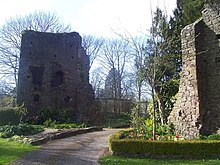
Back Earl of Devon German Comte de Devon French Conte di Devon Italian အားလ်ဒီဘွန် Burmese Graaf van Devon Dutch Граф Девон Russian Граф Девон Ukrainian Bá tước xứ Devon Vietnamese
| Earldom of Devon | |
|---|---|
  Arms: Quarterly, 1st & 4th: Or, three Torteaux (Courtenay); 2nd & 3rd: Or, a Lion rampant Azure (Redvers). Crests: 1st: Out of a Ducal Coronet Or, a Plume of seven Ostrich Feathers, four Or, three Argent (Redvers, Earl of Devon); 2nd: A Dolphin embowed proper (Courtenay). Supporters: On either side a Boar Argent, tusked and unguled Or. | |
| Creation date | 3 September 1553 |
| Creation | Fifth |
| Created by | Mary I of England |
| Peerage | Peerage of England |
| First holder | Edward Courtenay |
| Present holder | Charles Courtenay, 19th Earl of Devon |
| Heir apparent | Jack Courtenay, Lord Courtenay |
| Remainder to | 1st Earl's heirs male whatsoever |
| Subsidiary titles | Baronet, of Powderham Castle |
| Seat(s) | Powderham Castle |
| Former seat(s) | Tiverton Castle Colcombe Castle |
| Motto | 1st: QUOD VERUM TUTUM (What is true is safe) 2nd: UBI LAPSUS QUID FECI (Where I have fallen, what have I done?) |


Earl of Devon is a title that has been created several times in the Peerage of England. It was possessed first (after the Norman Conquest of 1066) by the Redvers family (alias de Reviers, Revieres, etc.), and later by the Courtenay family. It is not to be confused with the title of Earl of Devonshire, which is held by the Duke of Devonshire, although the letters patent for the creation of the latter peerages used the same Latin words, Comes Devon(iae).[1] It was a re-invention, if not an actual continuation, of the pre-Conquest office of Ealdorman of Devon.[2]
Close kinsmen and powerful allies of the Plantagenet kings, especially Edward III, Richard II, Henry IV and Henry V, the Earls of Devon were treated with suspicion by the Tudors, perhaps unfairly, partly because William Courtenay, 1st Earl of Devon (1475–1511), had married Princess Catherine of York, a younger daughter of King Edward IV, bringing the Earls of Devon very close to the line of succession to the English throne. During the Tudor period, all but the last Earl were attainted, and there were several recreations and restorations. The last recreation was to the heirs male of the grantee, not (as would be usual) to the heirs male of his body. When he died unmarried, it was assumed the title was extinct, but a much later very distant Courtenay cousin, of the family seated at Powderham, whose common ancestor was Hugh de Courtenay, 2nd Earl of Devon (d.1377), seven generations before this Earl, successfully claimed the title in 1831. During this period of dormancy, the de jure Earls of Devon, the Courtenays of Powderham, were created baronets and later viscounts.
During this time, an unrelated earldom of a similar name, now called for distinction the Earldom of Devonshire, was created twice, once for Charles Blount, 8th Baron Mountjoy, who had no legitimate children, and a second time for the Cavendish family, now Dukes of Devonshire. Unlike the Dukes of Devonshire, seated in Derbyshire, the Earls of Devon were strongly connected to the county of Devon. Their seat is Powderham Castle, near Starcross on the River Exe.
The Earl of Devon has not inherited the ancient and original Barony of Courtenay or the Viscountcy of Courtenay of Powderham (1762–1835); nevertheless, his heir is styled Lord Courtenay by courtesy.
- ^ "Comes", Latin "companion"; the original Norman earl was different from an Anglo-Saxon ealdorman or Norse jarl, being a companion of the Duke of Normandy who was the war leader or dux and in 1066 led his army across the Channel.
- ^ Thorn, Caroline & Frank, (eds.) Domesday Book, (Morris, John, gen.ed.) Vol. 9, Devon, Parts 1 & 2, Phillimore Press, Chichester, 1985, part 2 (notes), chapter 5. Thorn refers to Ordgar, Ealdorman of Devon as "Earl of Devon"
© MMXXIII Rich X Search. We shall prevail. All rights reserved. Rich X Search